The Honda Prologue isn’t really a Honda – in that it’s based on the Chevy Blazer EV – but it is different in a couple of ways that may make it worth a look if you’re wanting an EV sold by Honda.
The Prologue is a mid-sized/two-row electric crossover based on the Chevy Blazer EV.
It differs from its Chevy sibling in that it costs less to start – and goes farther to start – because it comes standard in a lighter, front-wheel-drive iteration (with one electric motor) while the Chevy comes standard with a dual-motor set-up and all-wheel-drive that adds a few hundred pounds to the curb weight and takes about 20 miles off the fully charged range.
It’s also less powerful – and so not as quick as the Blazer EV – but that’s how you go farther and avoid having to stop (and wait) sooner when you’re driving an EV.
Prices for the Prologue start at $47,400 for the base EX trim which comes standard with 296 miles of fully charged range and a single motor/FWD layout – vs. $48,800 for the base 2LT trim of the Chevy Blazer EV, which comes standard with a more powerful dual-motor drivetrain, AWD and 279 miles of range.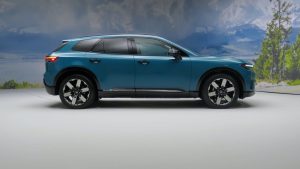
You can upgrade the base EX trim to essentially the same dual-motors set-up that’s standard in the Blazer for $50,400 – but this will cost some driving range, which goes down to 281 miles.
The mid-trim Touring version of the Prologue ($51,700) comes standard with the base EX trim’s front-drive/single motor set-up and the same 296 miles of range but more features and amenities than are included with the base EX. Once again, the more powerful dual-motor system (and AWD) are available optionally – at the cost of 15 miles of fully charged advertised range.
A top-of-the-line Elite trim – which lists for $57,900 – comes standard with the dual-motor set-up and AWD. Range for this model is only 273 miles even though it isn’t more powerful than the EX or Touring trims with the same basic set-up. It is, however, the heaviest version of the Prologue – 5,237 lbs. – and that probably explains why.
What’s New For 2025
The Prologue is the first electric vehicle to be sold by Honda.
What’s Good
Emphasis on how far it goes in between charges rather than how quickly it can get to 60.
Doesn’t seem to leak charge when parked (and not plugged in).
Costs less than basically-the-same-thing Chevy Blazer EV.
What’s Not So Good
Best-case fully-charged range isn’t very far (296 miles).
Home charge cord is not included as standard.
You’re not buying a Honda. You’re buying the Honda badge.
There actually is something under the Prologue (and Blazer’s) hood.
Well, something other than extra storage space.
Most EVs have a “frunk” – a second trunk – under their hoods. The electric motor/battery guts being hidden from sight. But you can see the Prologue’s primary electric motor – the one that powers the front wheels – if you raise the hood.
And that brings us to the interesting – the worth-mentioning – thing about the Prologue vs. the Blazer EV it’s based on. That being the Honda is available with just the one electric motor rather than the two that come standard in the Chevy.
This is why the Prologue comes standard with 212 vs. 288 horsepower and 296 miles of advertised driving range on a fully charged battery vs. 279 for the dual-motor (and heavier) Blazer EV. That may not seem like a big difference in driving range – and wouldn’t be, if we were talking about gas-engined vehicles – because it’s easy and quick to get more gas. It is often not easy – and it is never quick – to get electricity. Even at what are styled “fast” chargers – which are only that in relation to how much longer it takes to charge an EV at home.
So – with EVs – you have to be careful about running the thing down to empty or even too close to empty precisely because of the uniquely EV problems of finding more electricity (and having the time to wait for it).
“Fast” chargers are not as common as gas stations and it is common for “fast” chargers to be down – or other EVs already plugged in. Having an extra 17 miles of cushion is thus not a small thing and – more fundamentally – it telegraphs what is arguably an intelligent rethinking of the way EVs are designed.
Getting to 60 extremely quickly is fun – but it’s not very practical.
Making it where you want to go – without having to stop to wait before you get there – is.
If you want the 288 horsepower dual-motor set-up (which gives you all-wheel-drive) you can opt for that as a stand-alone option, even with the base EX trim.
What Honda does not offer is the high-performance drivetrain that’s available in the Blazer EV RS. That one offers up 340 horsepower (and a dual motor set up) as well an advertised maximum fully charge driving range of 324 miles, courtesy of a large battery pack that can store more electricity. The price you pay for that is $53,200 – the base price of the RS iteration of the Blazer EV.
Something else that’s different about the Prologue is that it does not come standard with a home-charge cord. You get to pick from three options:
The first option is a $750 EVGo fast charger debit card and an Electrify America 60kWh charging credit. But if you choose this option, you won’t get a home-charge cord kit and so you’ll either have to pay extra for one or charge your Prologue at commercial fast-charging kiosks only.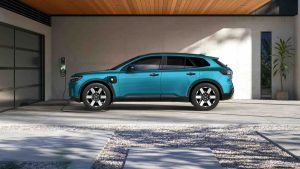
The second option is a Level II (240V) Honda home charging station that lets you charge at home – but not using a standard 120V household outlet.
“Level II” means you have to have a 240V electric dryer/stove-type outlet and that typically means wiring work to your electrical panel to add the circuit (and 30 amp breaker). This option does include a $500 Home Electrification installation credit to help defray the cost of that plus a $100 EVGo charging credit and a 60 kWh Electrify America charging credit.
The third option includes the Level 1 (120V) and Level II Honda portable charging kit that allows you to charge at home without having to pay to upgrade your home’s electrical panel. Plus a $250 Home Electrification credit in case you want to have your panel updated, a $300 EVGo charging credit and a 60kWh Electrify America credit.
The Prologue isn’t quick – the usual EV bragging point – but it is quick enough.
The standard single motor version can get to 60 in a bit over 6 seconds, a time that used to be considered very quick, for sporty/performance cars. It is only not-so-quick in relation to other EVs that get to 60 in four seconds or less – but while that’s certainly entertaining, it’s not necessary to be able to comfortably get up to speed and keep up with traffic. It also comes at the cost of range – especially if you regularly use that quickness capability.
Honda seems to believe that potential EV buyers might want more range – and less weight – as opposed to a quicker but heavier vehicle that not only burns through range more quickly but also uses more power – just the same as a non-EV with a big V8 engine uses more gas.
In any event, the single motor version of the Prologue is not slow to get going.
And like all electric cars, it feels even quicker than it is because of the immediate thrust provided by the electric motor, which (as in all EVs) generates its maximum torque immediately; gas (and diesel) engines must rev before they produce their peak power and that is why there is a lag – vs. the immediacy of the power delivery of the EV. And the power flows linearly- because there is no transmission; the motor spins the wheels directly.
It’s smooth, quiet and amply powerful for passing slow-movers and merging with faster-moving traffic.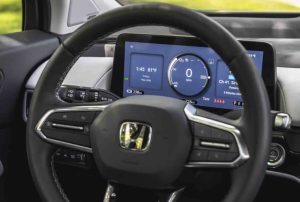
The only negative thing about the Prologue is the incongruity between the indicated range remaining and the actual driving range you have. The first day I drove the Prologue, the indicator said I had about 212 miles of driving range – equivalent to about 76 percent of the dual-motor Elite trim’s 273 miles of fully charged range. I drove into town – and back – which for me is a trip of roughly 60 miles, all told. When I got back, the indicator said the Prologue had about 110 miles of driving range left. Put another way, it had burned up – so to speak – about 100 miles of indicated range over about 60 miles of actual driving, a disparity of about 40 miles.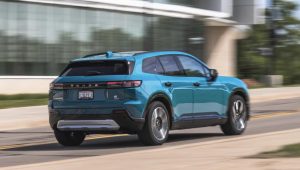
That’s a big disparity – and the very cold weather we had during the week I had the Prologue probably accounts for most of that, because very cold weather is a double whammy for EVs. The battery must power not just the electric motors but also the heat – for the battery and for you. Every EV has a thermal management system that is basically a heating (and cooling system) for the battery, which must be kept not too cold and not too hot. Along with you, of course. Plus the heated seats, if you use them.
Remember: In an electric vehicle, everything is electrically powered. The more accessories such as the heater are used, the faster the charge depletes.
Speaking of which.
The Prologue is the first EV out of dozens I have test driven that did not appear to lose charge when left sitting outside – unplugged – overnight. This seemed remarkable because the Prologue – like all EVs – has a thermal management system that uses power to keep the battery from getting too cold or too hot and that uses power (charge) and that is why every other EV I have tested that I left outside unplugged overnight seeped anywhere from 5-10 or so miles of range overnight.
But the Prologue didn’t seem to seep any range.
The word is in italics because think what actually happened is that it did seep range while sitting but the indicator didn’t show it. It only showed when I went for a drive. The computer – which is in charge of showing how much range (charge) remains – folding in the seepage losses into the losses incurred while driving. It’s kind of like an overly optimistic gas gauge in a vehicle with an an engine that stays on “full” for longer than the tank is actually full – leading you to believe it is full and that the car is burning less gas than it really is.
The difference is it’s easy (and fast) to get more gas while it is neither when you’re needing more electricity.
Especially if you are in a hurry.
The Prologue looks different but it is fundamentally a Chevy Blazer EV. Not – as Seinfeld used to say – that there’s anything wrong with that. It is common – historically – for different brands to “share platforms” to reduce the cost of designing completely different models independently. Examples include the Toyota Supra – which is fundamentally a BMW Z4. They look different, though – and they’re sold under different brands, which makes them more attractive to people who prefer one brand over another.
That’s pretty much the deal here, too. That – and the stuff up above about the Honda’s emphasis on practicality rather than how quickly it can get to 60.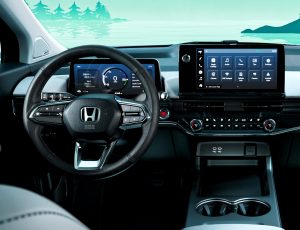
Being a “Honda,” the Prologue’s shape is a little milder in demeanor than the more rowdy-faced Chevy, which was styled to arouse Camaro-ish comparisons (kind of like the way the Ford Mustang Mach E was styled to evoke Mustang-ish comparisons). Looks are, of course, a question of taste but the take-home point is you have two different looks to choose from yet the underlying vehicle is basically the same. Like the Chevy Camaro vs. the Pontiac Firebird back in the ’90s and into the early 2000s.
Inside, the Prologue’s dash is similarly less rowdy than the Blazer EV’s and it’s not really a question of which is better but rather, which look you like better.
Both the Prologue and the Blazer EV are 192 inches long, seat five and have nearly identical space inside for cargo (25.2 cubic feet behind its second row and 57.7 cubic feet with them folded for the Prologue and 25.5 cubic feet and 59.1 cubic feet, respectively for the Blazer).
One difference is towing capability. The Honda is only rated to pull up to 1,500 lbs. while the RS version of the Blazer EV with it much stronger drivetrain is rated to pull up to 3,500 lbs.
Another is that the Honda comes standard with Apple CarPlay and Android Auto, which are not available with the Blazer EV. You also get in-dash GPS using GoogleMaps. 
The Rest
One small but very important feature the Prologue’s got is a charge port – basically, the fuel door in an EV – that is located up front on the driver’s side quarter panel. This means not having to back up to be close enough to reach the “nozzle” at EV fast charger kiosks.
The Bottom Line
The Prologue isn’t so much a re-skinned Blazer EV as it is an alternative take on the Blazer EV.
. . .
If you like what you’ve found here please consider supporting EPautos.
We depend on you to keep the wheels turning!
Our donate button is here. We also accept crypto (see below).
If you prefer not to use PayPal, our mailing address is:
EPautos
721 Hummingbird Lane SE
Copper Hill, VA 24079
PS: Get an EPautos magnet or sticker or coaster in return for a $20 or more one-time donation or a $10 or more monthly recurring donation. (Please be sure to tell us you want a magnet or sticker or coaster – and also, provide an address, so we know where to mail the thing!)
If you like items like the Baaaaaa! baseball cap pictured below, you can find that and more at the EPautos store!

The bitcoin code is: 3GAfymoqSUbaFvY8ztpSoDKJWCPLrkzAmi if you’re unable to scan the QR code above!


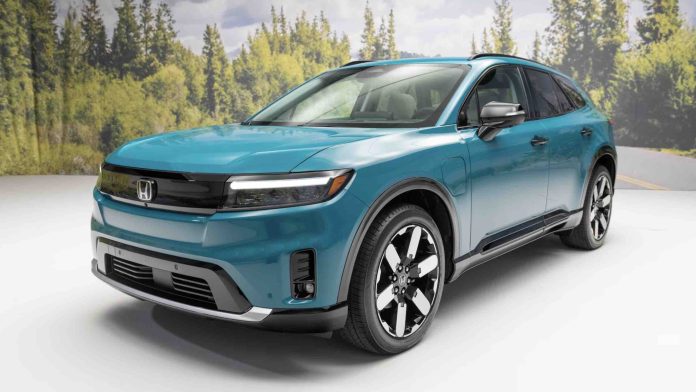


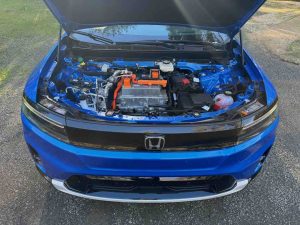
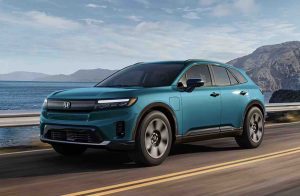








Just curious: Why would I buy a rebadged GM anything?
I know quality is down overall and I’ve heard about issues with newer Hondas, but GM? Forget it.
Why would you, or anyone, buy an electric device? Keep up with the Jones?
The price of a device alone is breathtakingly outrageous.
But there’s plenty of good little Goyim who will do as their (((masters))) bid and sign up for the electric conundrum.
Not me…cuz stupid is as stupid does….
Push to battery vehicles….and all heating, cooking etc. by electricity….total control….bad social credit score?…cut off your electricity…..you freeze to death…and no cooking or mobility….can’t escape…..no mobility….you can’t pay cash to recharge…
With a diesel ice….escape…..you could go 1000 miles…then refuel in 5 min…then go another 1000 miles…..pay cash at the gas station….they can’t cut you off…..
Then once they herd the unwanted slaves into 15 min city/prison camps……the solution is easy….cut off their water for 3 days…..dead….
The next-gen Honda EV will be called the Epilogue.
Has Honda ever rebadged another vehicle, besides the Isuzus vis-à-vis the Passport and Acura SLX?
“Prices for the Prologue start at $47,400 for the base EX trim which comes standard with 296 miles of fully charged range and a single motor/FWD layout – vs. $48,800 for the base 2LT trim of the Chevy Blazer EV, which comes standard with a more powerful dual-motor drivetrain, AWD and 279 miles of range.”
These OEM’s take us to be idiots that can’t do simple math. Unfortunately this is largely the case thanks to public schools that spend more time teaching about Diversity than reading, writing, and arithmetic.
So for about a 3% reduction in base price you give up AWD and more power (ie the ability to ground the power via AWD) for a measly 17 mile gain in range?
They might as well spit in your eye and call your momma a whore. How insulting.
Does a 3% difference in base price really make it more “affordable” when we are talking about a base price that is about 2/3 of the Median Household income in Merica’?
Ran it in an amortization calculator. $48,800, 60 months, 4% is $898/month.
$47,700, 60 months, 4% is $873/month.
Get real Honda! I used to respect Honda as a world class engine designer and manufacturer of quality engines. Now they are going to sell their heritage out thinking a measly $25/month cheaper price than GM is going to help them survive what’s coming? I will not forgive Honda for selling a rebadged GM and trying to pawn it off as a Honda.
Screw you Honda. I’ll dance on their grave when they implode like the rest. FAFO.
PS: Eric, I hope you’ve resolved your generator or transfer switch gremlins yesterday!
I saw a video of another Tesla charging station with a line around the block… and the next block… and a third block. I’m sure this was a situation where a lot of people converged on one town over the holidays, overloading the local infrastructure. Design your charging network for 85% of normal need. But this sort of thing is going to be another achilles heel as more EVs are sold. There won’t be any overcapacity because there’s not a lot of competition. And that competition is seriously capitalized.
I’m not sure I know how gas stations go about getting their pumps and related infrastructure. I know I see a lot of Veeder-Root equipment at gas stations. I’m sure there are other companies making gas pumps too. Seems like something a small business would buy, have installed and operate. Compare that to a fast/DC charging station. Semens and ABB, two companies that are known for electric utility switchgear, but also Tesla, Electrify America (VW), EVgo (GM and Nissan), Shell, BP, and a few Asian players. (ChatGPT)
How is a small business going to compete with the well funded (but actually barely funded if the goal is to replace every gas pump in the world) automakers and oil companies? Perhaps they can get a franchise, but there are A LOT of independent fuel stations in the US. The other group missing on this list is the power companies. You’d think if EVs were a way to sell more product the utilities would be all in on them. But no. They’ll sit back and just let everyone else lose their shirts.
The EV push is all about the car. But that’s like selling a phone without a communications chipset. Sure it’s useful, but without cellular or WiFI they’re not going to do much of anything. If there’s no charging network to back up your EV purchase, it’s really not going to go very far beyond your driveway.
Compare that to a fast/DC charging station.
Fast charging stations don’t exist, so any comparison would be pure fantasy.
Jumbo shrimp.
English is one hell of a language. You can make up anything by simply adding adjectives.
Yeah, that particular feature is especially useful for those who want to tell lies.
“Level II” means you have to have a 240V electric dryer/stove-type outlet and that typically means wiring work to your electrical panel to add the circuit (and 30 amp breaker).”
My grandson called me a curmudgeon so I’m trying to be more optimistic in general, hence, looking for silver linings. Guess you could up the breaker to 50A and run a sick or wire welder.
Unless it has to be 30A specifically for an EV. Defer to the EEs & smart folks here…
The breaker protects the wire from overheating. All spelled out in the NEC.
Most of the EV chargers I’ve seen have a plastic molded plug that probably won’t be easily replaced, although my solar inverter has dedicated lugs for an EV charger, so my guess is if you were to open up the box there’d be lugs connecting that cable for replacement with a different plug or hard-wiring to the panel. If the plug is a typical electric drier or range plug, it is probably going to be a 30A, even if the wire size is rated to 50A. That’s OK. In fact most of my house is wired for 20A circuits but the plugs are 15A, other than the ones I’ve upgraded over the years.
Most charging cables with boxes aren’t doing much of anything other than providing a status indicator. The chargers are in the EV itself. This also creates a situation where even if you do have a 50A circuit available the EV will likely limit charging to 30A because that’s the default. Much like US heating products limit to 1500 W because that’s under 15A on a 120V circuit. You might have higher capacity circuits available, but the manufacturers aren’t going to specify higher current because they know people aren’t going to take the time to understand the difference. And that’s assuming you have good 240 split phase into the house. Undervoltage throws all those calculations off, so design in more margin.
Wear the title of curmudgeon proudly.
So tired of youth that are high on hopeium but know nothing about how the world works and can’t see how they are being screwed over largely because they can’t do simple math and have no ability to train in a logical, linear manner.
Hopefully your grandson is an exception.
“ Guess you could up the breaker to 50A and run a sick or wire welder.”
It’s not that simple unless your electrical panel has 1) the excess capacity, 2) the physical space for the breaker 3) you upgrade the wire to handle 50A vs 30A.
Most breakers in the US are 100 amp main (older homes) or 200A (newish). Heck, there is still old housing stock from the 50’s and earlier that still have a 60A service with old screw in Buss fuses! Good luck just throwing a 50a sub panel on that!
The point being – physical reality, physics, and such matters.
Optimism is nice but unless it’s grounded in reality, it’s just hopeium which is basically a mental disorder based on delusional thinking that has no basis in reality.
‘This is why the Prologue comes standard with 212 vs. 288 horsepower and 296 miles of advertised driving range on a fully charged battery vs. 279 for the dual-motor (and heavier) Blazer EV. ‘ — eric
Reducing the motor power rating by 26% (still plenty quick, as Eric points out) gains only 17 miles of range. Not a very impressive trade-off.
Fundamentally, EeeVee batteries remain a poor energy storage option compared to hydrocarbon fuel. They are much heavier, with much lower energy density, need parasitic thermal management coddling, and occasionally go BOOM at inconvenient moments.
I’ll pass, thank you.
‘But you can see the Prologue’s primary electric motor – the one that powers the front wheels – if you raise the hood.’ — eric
Eeeek! Kinda like peeling back a flap of skin after getting injured, and seeing your bare bone poking through.
I don’t think I can handle this. Why no black plastic modesty cover for squeamish EeeVee owners? /sarc